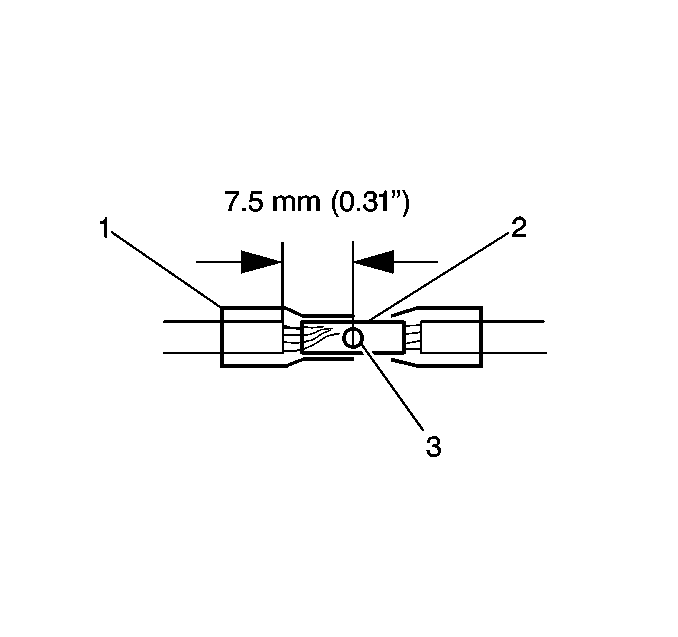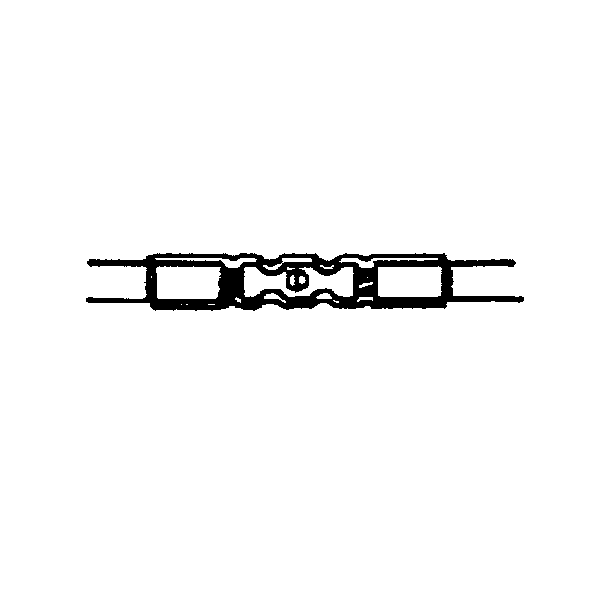Special Tools
| • | DuraSeal splice sleeves, in order to repair the SIR/SRS wiring |
| • | EL-38125-10 Splice Sleeve Crimping Tool |
| • | EL-38125-5 Ultra Torch |
For equivalent regional tools, refer to Special Tools.
Note: Use only DuraSeal splice sleeves. Other splice sleeves may not protect the splice from moisture or provide a good electrical connection.
Use DuraSeal splice sleeves to form a one-to-one splice on all types of insulation except tefzel and coaxial. Use DuraSeal splice sleeves where there is special requirements such as moisture sealing. Follow the instructions below in order to splice copper wire using DuraSeal splice sleeves.
Splice Sleeve Color | Crimp Tool Nest Color | Wire Gage mm² / (AWG) |
|---|---|---|
Salmon (Yellow-Pink) 12089189 | Red (1) | 0.035-0.8/(18-20) |
Blue 12089190 | Blue (2) | 1-2/(14-16) |
Yellow 12089191 | Yellow (3) | 3-5/(10-12) |
Green 88988379 | Red (1) | 0.22-0.35/(22-26) |
- Open the harness by removing any tape:
- Cut as little wire off the harness as possible. You may need the extra length of wire in order to change the location of a splice.
- Strip the insulation:
- Select the proper DuraSeal splice sleeve according to the wire size. Refer to the above table at the beginning of the repair procedure for the color coding of the DuraSeal splice sleeves and the crimp tool nests.
- Use the EL-38125-10 splice sleeve crimp tool in order to position the DuraSeal splice sleeve in the proper color nest of the splice sleeve crimp tool. The crimp tool has four nests, one for each color.
- Place the DuraSeal splice sleeve in the nest. Ensure that the crimp falls midway between the end of the barrel and the stop. The sleeve has a stop (3) in the middle of the barrel (2) in order to prevent the wire (1) from going further. Close the hand crimper handles slightly in order to firmly hold the DuraSeal splice sleeve in the proper nest.
- Insert the wire into the splice sleeve barrel until the wire hits the barrel stop.
- Tightly close the handles of the crimp tool until the crimper handles open when released.
- Using the heat torch, apply heat to the crimped area of the barrel.
- Start in the middle and gradually move the heat barrel to the open ends of the tubing:
Note: You must perform the following procedures in the listed order. Repeat the procedure if any wire strands are damaged. You must obtain a clean strip with all of the wire strands intact.
| • | Use a sewing seam ripper, available from sewing supply stores, in order to cut open the harness in order to avoid wire insulation damage. |
| • | Use the DuraSeal splice sleeves on all types of insulation except tefzel and coaxial. |
| • | Do not use the crimp and DuraSeal splice sleeve to form a splice with more than 2 wires coming together. |
Adjust splice locations so that each splice is at least 40 mm (1.5 in) away from the other splices, harness branches, or connectors.
| • | When adding a length of wire to the existing harness, use the same size wire as the original wire. |
| • | Perform one of the following items in order to find the correct wire size: |
| - | Find the wire on the schematic and convert to regional wiring gage size. |
| - | If you are unsure of the wire size, begin with the largest opening in the wire stripper and work down until achieving a clean strip of the insulation. |
| • | Strip approximately 7.5 mm (0.313 in) of insulation from each wire to be spliced. |
| • | Do not nick or cut any of the strands. Inspect the stripped wire for nicks or cut strands. |
| • | If the wire is damaged, repeat this procedure after removing the damaged section. |



The crimper handles will not open until you apply the proper amount of pressure to the DuraSeal splice sleeve. Repeat steps 4 and 5 for the opposite end of the splice.

| • | The tubing will shrink completely as the heat is moved along the insulation. |
| • | A small amount of sealant will come out of the end of the tubing when sufficient shrinkage is achieved. |
